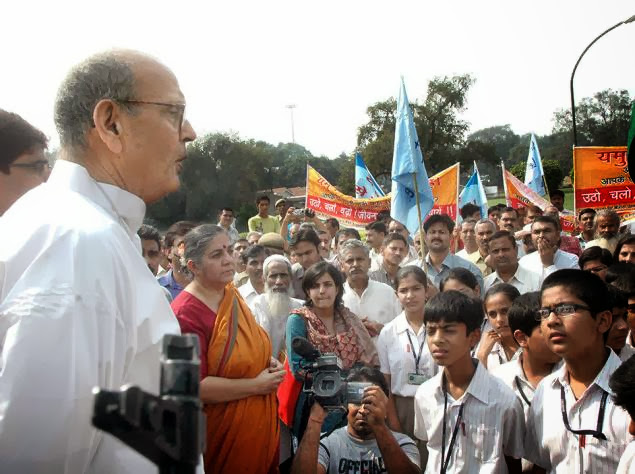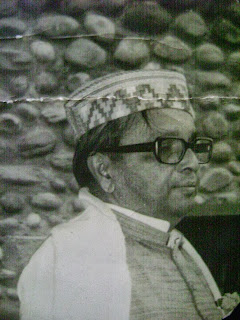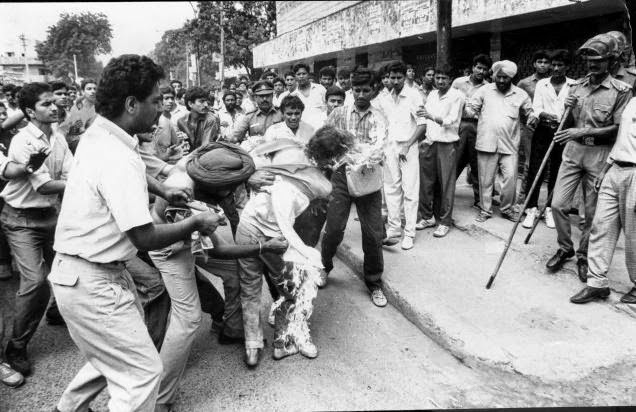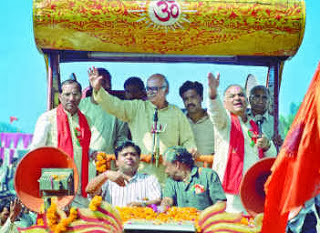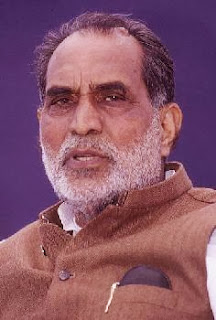Rise and fall of V P Singh - General Elections 1989 - Emergence of caste politics in large scale
In our earlier article, we discussed about the rise and fall of Rajiv Gandhi. We also discussed...

In our earlier article, we discussed about the rise and fall of Rajiv Gandhi. We also discussed about how Rajiv Gandhi opened up communal politics by appeasing both Muslims and Hindus simultaneously. We also discussed how Rajiv Gandhi started his 1989 Election Campaign from Ayodhya promising 'Rama Rajya'. With the net result, Rajiv Gandhi lost the trust of both Muslims and Hindus.
Meanwhile, V P Singh, one his senior Cabinet Ministers raised allegation against Rajiv Gandhi bringing out Bofors scandal. He was dismissed from the Cabinet. V P Singh started a new political outfit known as 'Jan Morcha' in 1987 to fight against corruption. He became popular throughout the country as a crusader against corruption.
V P Singh formed 'Janata Dal' On 11th October 1988 merging Jan Morcha, a faction of Janata Party led by Chandra Shekar, Lok Dal and Congress (S). The newly formed Janata Dal became popular throughout India, as a party to fight corruption.
V P Singh also formed a coalition called 'National Front' with parties like DMK (Tamil Nadu), Telugu Desam Party (Andhra Pradesh), and Assam Gana Parishad (Assam). N T Rama Rao (TDP) was the Chairman of National Front and V P Singh was the Convenor to face the Elections of 1989.
V P Singh addressing the public - Photo courtsy The Hindu |
V P Singh finalised an electoral understanding with Left parties and BJP, to fight against the Congress. Though V P Singh wanted the support of BJP, during elections, he wanted to keep distance with them. V P Singh did not share platform with BJP. In some places where BJP and V P Singh were to hold a joint rally, V P Singh and BJP leaders were addressing the public from two different stages. Since BJP at that time had an agenda of constructing Ram Temple at Ayodhya, VP Singh wanted to distance himself away to maintain his 'secular image'.
1989 Election results
Janata Dal Election symbol |
9th General Elections were held for 545 constituencies on 22nd and 26th November 1989. At that time India had 49.89 registered eligible voters. Of them, 61.95% turned out to vote in the elections.
The newly formed Janata Party fought elections with a new symbol of 'chakra'. 'Corruption' and 'Bofors scandal' was the main agenda of the elections.
Congress led by Rajiv Gandhi had secured 197 seats (vote share of 39.5%) and emerged as the single largest party. It may be noted that in the 8th Lok Sabha, Congress had secured 404 seats with vote share of 49.01%) and their strength was reduced to less than half during the 9th Lok Sabha. It was because of the corruption charges levelled against Rajiv Gandhi and also the electoral alliance of all the opposition parties with the sole objective of 'anti congressism'.
The Janata Dal led by V P Singh secured 143 seats (vote share 40.7%) and became the second largest party. Left parties secured 45 seats (vote share 9.1%).
BJP which had 2 seats in the 8th Lok Sabha improved its position and secured 85 seats now (vote share 11.36%).
While DMK could not get any seat, TDP secured 2 seats. National Front could not pick up seats in South India.
Times of India dated 3rd December 1989 |
Since Rajiv Gandhi could not form the Government, though he was heading the single largest party, V P Singh formed the 'National Front Government' on 2nd December 1989. Devi Lal became the Deputy Prime Minister. Left parties and BJP gave outside support to V P Singh. Rajiv Gandhi became the leader of the opposition.
Interestingly, during this period, National Front was in power in 10 States in India, including Haryana, Gujarat, UP, Andhra, Kerala, Bihar, Tamil Nadu, etc. Ironically, in Kerala they shared power with Left parties and in Gujarat, they shared power with BJP. This could not last long.
Challenges during V P Singh's regime
Janata Dal was formed with ambitious leaders of different ideologies, with the sole aim of 'anti congressism'. The Government depended on both Left and BJP of opposite ideologies. Besides VP Singh had to face internal crisis also within the party.
Though V P Singh campaigned against corruption and came to power, he did not do anything to take the Bofors scandal further. During his time, economy further worsened. Prices started rising abnormally. Foreign exchange reserve went to a dangerous level. India joined the list of 'debt defaulters'.
In Kashmir, the situation worsened. Nearly 90,000 Hindus were driven out of valley and they became refugees in their own land by migrating to other places. This is the greatest refugee migration in Indian history.
Implementing Mandal Commission Report
B P Mandal |
Since Rajiv Gandhi was playing earlier both Muslim and Hindu cards simultaneously during his term as PM, BJP cleverly consolidated the Hindu votes in the North under the 'Ram Mandir' banner. Faced with lot of challenges both internally and externally, V P Singh suddenly wanted to consolidate 'backward class vote base' in his favour. On 7th August 1990, he issued orders implementing Mandal Commission Report.
Accordingly, some of the socially backward castes called 'Other Backward classes (OBC)' were given 27% reservation in all the Central Government jobs and admissions in educational institutions.
During Janata Government Morarji Desasi appointed a Commission with Mr B P Mandal (a senior MP from Bihar) as Chairman and 5 others as Members on 20th December 1978, to recommend reservations for most backward class people. The Commission submitted its report on 31st December 1980 to then Prime Minister Indira Gandhi. This report was not implemented both by Indira Gandhi and Rajiv Gandhi for various political reasons, fearing backlash.
Suddenly V P Singh preferred to open up the report and implement with immediate effect. V P Singh earned the name as champion of 'social justice'. Unfortunately, many of his own party leaders did not like the way he implemented the report. BJP felt threatened that it might affect their vote base and Hindu unity.
For the first time, in India, caste politics emerged in a large scale.
Self immolation and riots
The implementation of Mandal report had adverse impact on some of the major castes in North India. They protested against V P Singh. The castes which were benefited by the reservation supported V P Singh. They hailed him as the champion of social justice. The implementation divided the people on caste lines.
Student Rajiv Goswami attempting self immolation. |
One Delhi University Student Rajiv Goswami attempted self immolation, but he was saved. This triggered more self immolations. Around 75 students in the North self immolated themselves, protesting against the Mandal report. In the riots followed, more than 200 people died.
Mandal to Mandir: BJP's Rath yatra
As we discussed earlier, Rajiv Gandhi's playing both Muslim and Hindu appeasement simultaneously during his term as Prime Minister, brought 'Ram Mandir' issue to the centre stage. Ram Mandir issue was an unifying factor among Hindus. Though Rajiv Gandhi started his 1989 campaign from Ayodhya with the promise of 'Rama Rajya', he could not succeed in consolidating Hindu votes in favour of Congress. BJP played Ram issue carefully and increased their seats in Lok Sabha from 2 to 85. Now that, V P Singh's Mandal card, unexpectedly brought the caste factors to the centre stage and it developed caste hatred within Hindus.
BJP's Rath Yatra with L K Advani |
Again to consolidate the Hindu votes and to counter the Mandal effect, BJP undertook a 'Rath Yatra' from Somnath to Ayodhya with L K Advani leading the yatra. L K Advani started his yatra from Somnath on 20th Sep 1990 with an aim of reaching Ayodhya on 30th October 1990. The focus was on building Ram Mandir at Ayodhya. Though the yatra generated lot of interest and consolidated Hindu votes, it also generated communal backlash in many states. While starting the yatra, Advani had warned V P Singh that if he were to be arrested, he would withdraw the support to the Government.
Arrest of Advani and withdrawal of support by BJP
Since the Rath Yatra was generating law and order problem in many places, then Chief Minister of Bihar Lalu Prasad Yadav arrested Advani at Samastipur and stopped the yatra on 23rd October 1990. BJP withdrew their outside support immediately to V P Singh Government.
Fall of VP Singh Government
Chandra Shekar |
Meanwhile, Chandra Shekar and Devi Lal came out of Janata Dal with 64 Members to form Samajwadi Janata Party (Rashtriya) on 5th November 1990.
V P Singh lost the vote of confidence in Lok Sabha on 7th November 1990 and he had to resign.
With the outside support of Congress led by Rajiv Gandhi, Chandra Shekar was sworn in as Prime Minister on 10th November 1990. Chandra Shekar had the direct support of 64 MPs and outside support of Congress with 197 MPs.
Challenges faced by Chandra Shekar
Chandra Shekar inherited a bad economy with foreign exchange reserves going down to dangerously low level. The country slipped into the list of 'debt defaulters'. He had to pledge gold reserves of the country to manage the situation. That brought down the image of the country worldwide.
The law and order of the country was very bad in the country, due to Mandal-Masjid issues.
Though he wanted to provide a better governance, he could not do better, since he had only 64 MPs on his side. He was managing the Government with outside support of Congress.
Fall of Chandra Shekar Government
Chandra Shekar was sworn in as PM on 10th November 1990. When the Budget session was going on, Rajiv Gandhi withdrew the support to Chandra Shekar on 6th March 1991 with a flimsy reason that two police constables were spying on Rajiv Gandhi. Hence, Chandra Shekar could not submit a regular budget. 9th Lok Sabha was dissolved by President. Chandra Shekar was requested by the President to continue as Prime Minister till the new Government was formed after the Elections. Chandra Shekar continued as PM till 21st June 1991, when Narasimha Rao took over as Prime Minister.
Turbulent period of 1988-1991
The period between 1988 and 1991 was highly turbulent in India. Communal and caste politics emerged in large scale during this period. No party in India, be it Congress, BJP, Left or Janata party descendants can claim to be truly secular. In order to strengthen their vote base, they indulged in either communal or caste politics, under the guise of secularism.
Further during the middle of General Elections 1991, Rajiv Gandhi was assasinated (May 1991). This incident also further worsened the economy of the nation.
With so much of confusion around, Narasimha Rao, a senior leader, who was ignored and sidelined by Congress took over as Prime Minister in 1991 and managed the crisis silently and successfully successfully for five years.
In our next article, we will discuss the happenings in the post Rajiv Gandhi era.
By Prime Point Srinivasan



